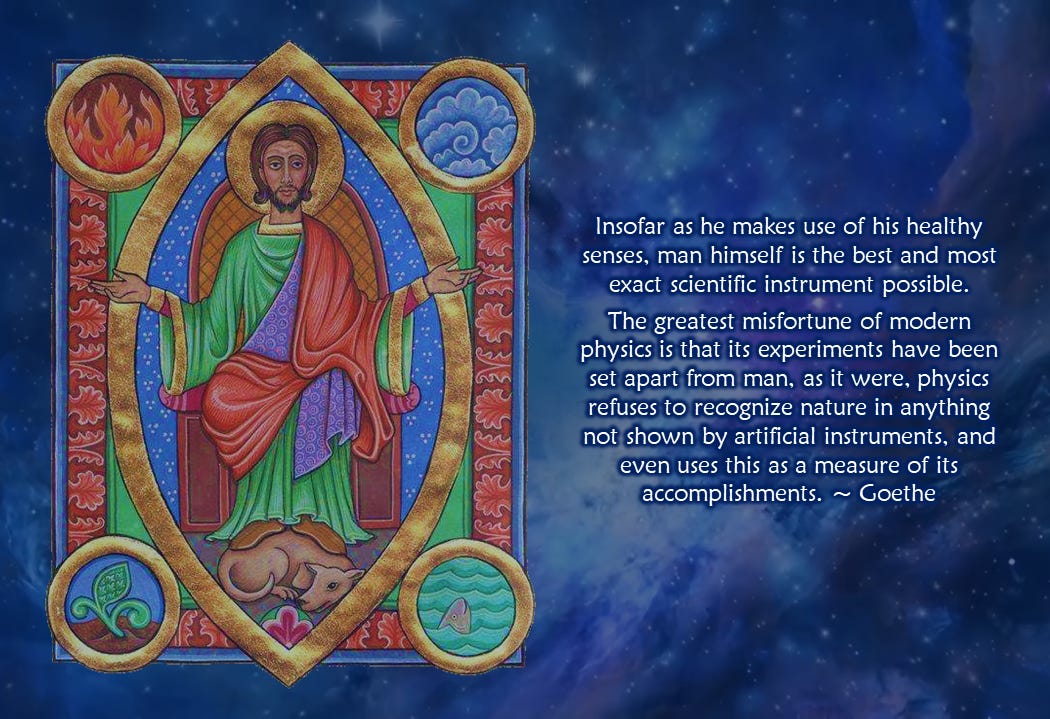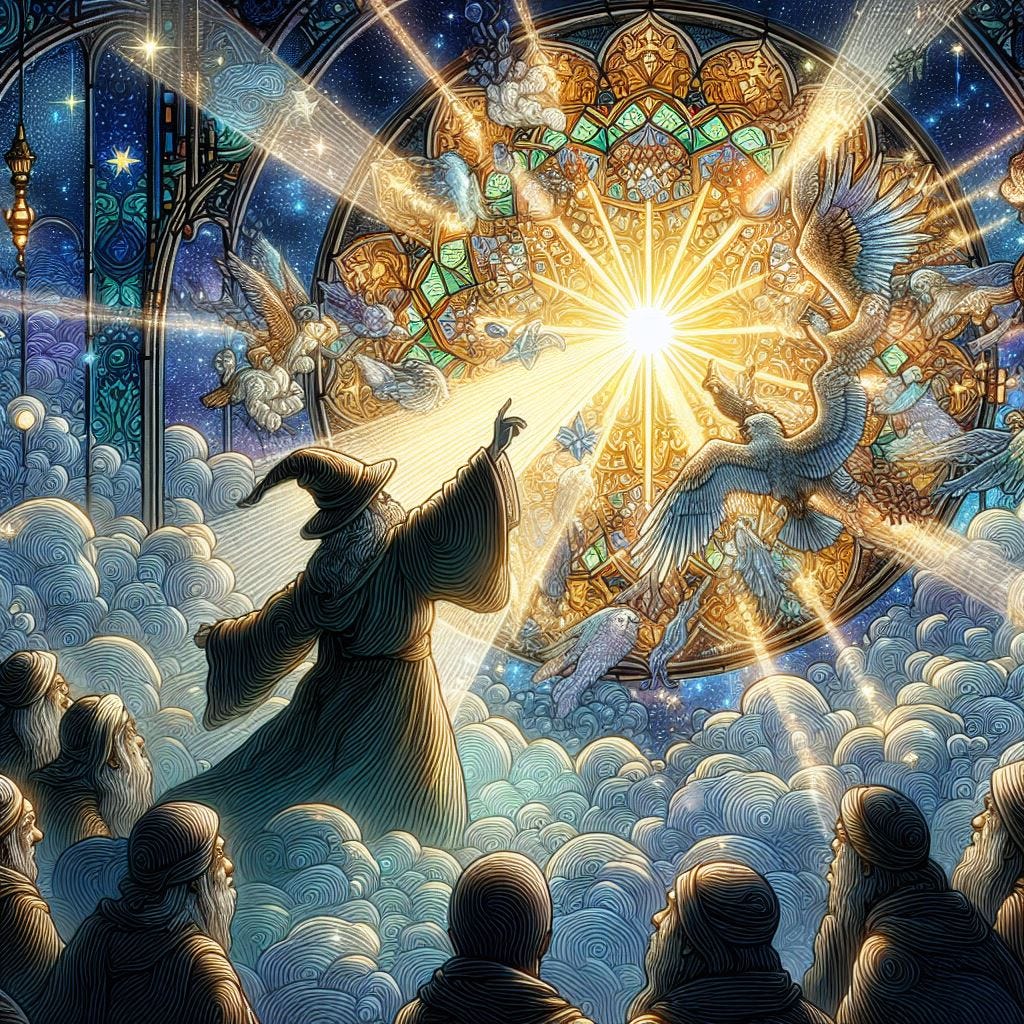“The time has come to realize that supersensible knowledge has now to arise from the materialistic grave.” ~ Rudolf Steiner
Rudolf Steiner taught that the development of the discursive approach — only that which can be weighed and measured — beginning its emergence during the 15th century, marked a major shift in human consciousness. This transformation involved the externalization of subjective experiences, including proprioceptive sensations of the body's structure, into objective systems such as the Cartesian coordinate system. Humanity was no longer in the center of creation, but rather adrift amongst the stars.
Prior to our present age human consciousness experienced its own thinking as part of Nature. In essence, humans were at the center of their universe in their relationship with spiritual forces. However, with the emergence of discursive consciousness, thinking became more private and individualized, separated from the natural world. Heliocentrism, while the dominant apparent result of scientific measurements and determinations, signaled the increasing insignificance of the individual into the abject humanism of today.
This emergence of discursive consciousness allowed for greater individual freedom and autonomy, but with a price. This new form of thinking has obvious limitations, yet it is necessary to develop higher levels of consciousness to fully comprehend the spiritual dimensions of our world, though not apparently. This externalization represented a shift away from direct spiritual experience and towards a more mechanistic and materialistic view of the world.
This transformation marked the beginning of a process of humanity’s descent beneath matter, into atomism and electrical thinking, where humans have become disconnected from the spiritual dimensions of reality and only approach them abstractly. Atoms, or what’s beneath them, are separated from the irreducible wholeness of manifestation, thereby forever preventing a true scientific process of comprehending the whole.
This externalization is a double-edged sword, necessary for the evolution of human consciousness and the development of the sciences, but is also a source of spiritual alienation and materialism. It is possible to overcome the negative consequences of this transformation by consciously re-integrating subjective experiences and spiritual awareness into science and culture through the Goethean scientific method.
While I shall iterate this in more detail, and extrapolate into process and practice in future articles, as an introduction:
The Goethean scientific process is a wholistic approach to comprehending natural phenomena. It utilizes observation and experience over abstraction and analysis.
The stages are as follows:
Observation: Make careful and detailed observations of natural phenomenon, without abstract reasoning or preconceived notions.
Phenomenological Description: Describe the phenomenon in its own terms, as a whole, without breaking it into parts, or reducing it to simpler concepts or existing categories.
Imagination: Use imagination to form a mental image of the phenomenon.
Conceptualization: Develop a concept that captures the essence of the phenomenon, as interconnected and interdependent with all things.
This leads to an archetypal comprehension of Nature, in which the observer cognizes the underlying principles and interconnectedness of natural phenomena, experiencing all as unified wholeness.
This process trains one to observe the world in its entirety as a participant, rather than breaking it down into smaller, isolated parts separate from consciousness as does the discursive approach.
Goethe's methodology is a way to bridge the gap between discursive consciousness and higher levels of intuitive consciousness, overcoming the limits of the onlooker consciousness. Goethe's approach is a way of cultivating a holistic, intuitive understanding of the natural world. By engaging in careful observation and reflection, one may develop a deeper connection to the natural world and thereby to the overarching spiritual realms from which it emerges.
This is not just another conceptual philosophy, but rather our inherent spiritual birthright. It is the pathway to what Rudolf Steiner termed the “supersensible.”
“Goethe does not flee from reality in order to create an abstract world of thoughts which has nothing in common with reality; no, he goes deeper into reality, into its constant changes, its becoming and moving, in order to find the immutable laws; he confronts the individual (phenomenon) in order to see the archetype in that individual. Thus there arose in his mind the archetypal plant and the archetypal animal which are nothing other than the Idea of the animal, the Idea of the plant. These are no empty, general concepts which belong to some grey theory; they are the essential bases of organisms, with a rich, concrete content, full of life and clarity.” ~ Rudolf Steiner
The Goethean approach leads to the development of a higher level spiritual-scientific consciousness, characterized by a direct, intuitive comprehension of the spiritual dimensions of the world. One learns to cognize the archetypal ideations from which this world has emerged.
The spiritual world is not seen as anything to be simply believed in, but rather one where we reconnect with the spiritual forces of creation through the conscious effort of cognizing natural processes, whilst engaging in concomitant inner development. This inner development leads to a metamorphosis from an external focus to an internal focus, where faith transforms into knowledge and clairvoyance into intellectual capacity.
“We must not be misled when we meet people who have not advanced by means of intellectual comprehension, but have certain psychic abilities that seem to appear spontaneously. Based on our comprehension of the mission of spiritual science, we know that souls can now think only because the clairvoyance of an earlier age has been suppressed. People with natural clairvoyance, which was not acquired through inner effort, must be seen as persons who have remained at an earlier evolutionary stage and who should therefore receive special care in our Society, rather than be considered particularly advanced. It would be an incorrect judgment if we were to consider such souls particularly mature, as having experienced particularly high incarnations. People with a natural gift of clairvoyance have gone through far less than those who are thinkers nowadays.” ~ Rudolf Steiner
The awakening of our inner forces by conscious connections to macrocosmic forces leads to a deeper comprehension of the interconnectedness of the macrocosmic and microcosmic forces in the universe. Through this process, we gain insight into the primality of spirit and our connection to the Divine, providing a refined and astute perspective of our place in the cosmos.
In this, the cognition of the researcher is paramount. One encounters a non-hypothetical approach, the opposite of Popper’s falsification principle. Because in life there are obvious phenomena that are not reproducible, yet are essential to our experience. We cross the boundary of the physical-material to the supersensible, where we can discern the roots of true being.
The worthy aim of any intelligent cognitive scientific approach is to learn more about Nature than merely its physical-material precipitate, to cognize the spiritual source of life and being in a dynamic and functional manner. Matter and spirit are experienced as an interconnected wholeness.
This engenders a metamorphosis to a new phase in the spiritual development of humanity, individually and collectively. One in where we cognize in terms of metamorphosis and polarity.
In metamorphosis we will explore Goethe’s metamorphosis of plants as a model to create new organs of cognition using our imagination as a tool of higher consciousness; and, in polarity, through Goethe’s non-Newtonian theory of color. And through these new organs of cognition we build in our consciousness we can begin to perceive the higher worlds.
“Goethe believed that the true Theory is contained in the Phenomenon. The phenomena our senses see do not deceive us; they are not unlike the ideal reality which brings them forth. As the Greek origin of the word implies, the ‘Theory’ is the true seeing of the thing - the insight that should come with healthy sight. Yet man is so constituted that he does not really see unless he meets what he sees with spiritual activity on his own part.” ~ Olive Whicher
The spiritual-scientific, or more properly cognitive-scientific approach is a functional process integrating our spiritual development with discursive knowledge of the processes of nature. Upon this we build higher modes of cognition through developing the imagination and intuition as reliable tools for seeing beyond the discursive, seeing with the eye of the spirit.
In order to approach these modes one must comprehend what an idea truly is, how one may ideate the archetypes overarching living systems.
So what then is an idea?
Support Independent Research into Hidden Knowledge & Unexplored Dimensions
Thank you for reading. If this work has resonated with you, stirred your thinking, or opened new perspectives, know that your engagement is not passive—it is participatory. This research explores the neglected frontiers of consciousness, cosmology, and sacred history, illuminating the structures of reality often dismissed by institutional narratives.
🎯 Make a Direct Impact
🔸 PayPal: paypal.me/alkemix33
🔸 Explore the Course — Archetypal Vision: alkemix.gumroad.com
🔸 Wear some Sacred Threads: etsy.com/shop/AlkemixArts
Why It Matters
Each contribution directly supports:
Deep-dive investigation into suppressed and forgotten knowledge
Explorations of alternative scientific, metaphysical, and historical paradigms
The creation of original, symbolically informed content that challenges surface-level narratives
The preservation and renewal of initiatic traditions in a post-dogmatic world
Whether you share, support, or engage in meaningful dialogue, you’re participating in the reawakening of a deeper mode of knowing—one that sees through the surfaces and listens to the living heart of things.
“Give, and you are instantly richer—what you offer becomes your power.” — Plotinus
What people say about my work:
“Thomas’ lectures are worth watching several times. Gold in every minute. So grateful for them.” —JE
“The absolute best. It always fills me with joy to watch Thomas’ lectures, restores my sanity in these crazy times.” —KS
“I so love your work. You’re a beautiful human angel.” —JG
“Your work is very important, continues to be a solid support and inspiration to me through all the madness, Thomas - thank you!” —K
“Thomas has labored long and mightily in that most difficult of all assignments: presentation of new ideas and conceptions to a world determined to go to hell.” —Trevor James Constable













Maybe an 'ID'ea is a grade within the tuition of the 'IN'ner or intuition
I'm following along, as best I can, giving these ideas a place to develop in my mind. I like that comparison of seeing and hearing are perceptions as likewise ideas are perceived.